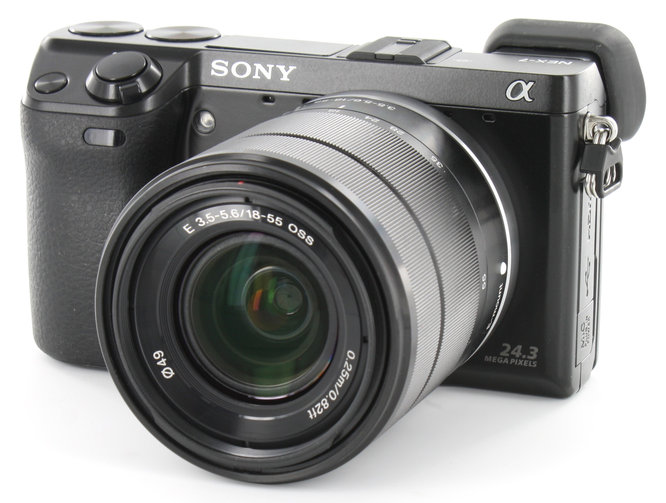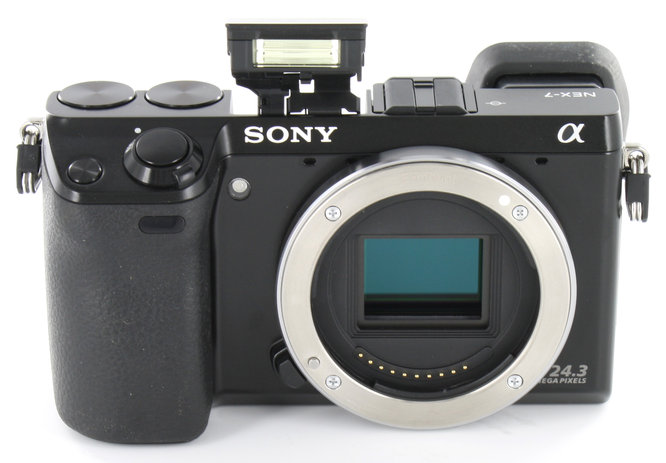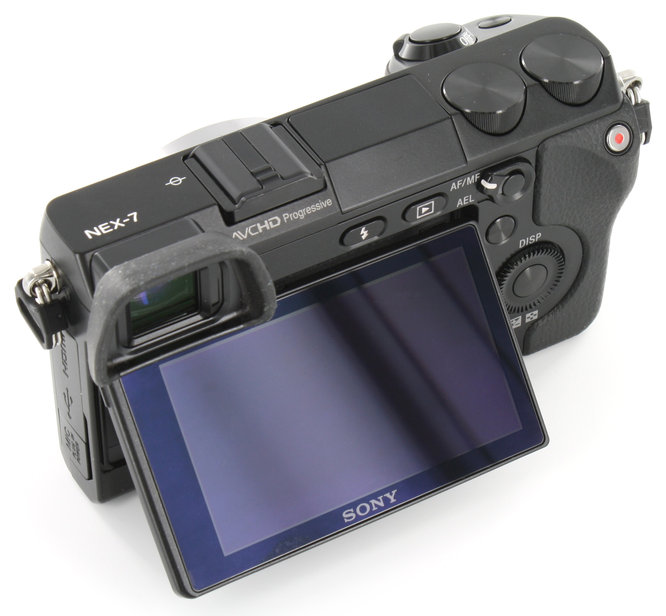This
high-end NEX model blends a high-resolution sensor with an OLED viewfinder.

Sony NEX-7 Front
Sony's most
advanced NEX model comes with an array of impressive functionality but,
predictably, at a high asking price.
Headline
features include a 10fps burst mode, ISO 100-16,000 sensitivity, a 3in LCD
screen mounted on a tilt-angle bracket and a built-in OLED electronic
viewfinder (EVF).
With an
APS-C sized sensor sporting 24.3MP the camera seems well equipped for
enlargements and more severe cropping, and it's able to capture 1080p HD movies
too.
Of course,
as a CSC model, the NEX-7's mirrorless design makes
it a far smaller camera than its SLT cousins. As for flash functionality, the
NEX-7 ditches the Smart Accessory Terminal common to previous NEX models, and
instead opts for a built-in flash alongside a Sony/Minolta standard hotshoe for external units.

Sony NEX-7 Pop Up
Flash
The NEX-7
is a curious-looking beast, due in part to its two blank rotational wheels on
the top-plate. While odd to the eye, this isn't a problem in use as the thumb
naturally falls on one of them. The one big problem we did find was that the
control wheel closest to the camera's outer edge would frequently get knocked
and then shift the exposure compensation by 0.3-0.7EV
in either Program, Aperture Priority or Shutter Priority modes.
Quite why
the NEX-7 has no physical mode dial is a design decision that's beyond us. A
camera at this level that demands menu-digging to shift between manual controls
has missed part of its very purpose.
The
autofocus system, while reasonably prompt, is not as quick or accurate as those
found in competing cameras from the likes of Nikon, Olympus or Panasonic. The AF's
biggest enemy, however, is low light. Dim conditions, despite the inclusion of
an AF-illuminator lamp, did throw the AF system off kilter occasionally.
Where the
NEX-7's performance does speed up is with its 'Speed Priority Continuous' 10
frames per second (fps) burst mode. Even when shooting Raw + JPEG Fine the
camera can reel off 10 shots in one second without flinching (or a maximum of
12 JPEG Fine shots). However focus and exposure is fixed during the burst
unless you use the standard continuous shooting mode at around 4fps.

Sony NEX-7 Rear Angle
The
2.4m-dot EVF, also found on the A77 SLT model, is no ordinary viewfinder; it
does a sterling job in terms of clarity and fluidity. Coverage is 100% and with
a magnification of 1.09x it feels far from
tunnel-like.
Images
display a smooth tonal range, plus there's the D-Range Optimiser
(DRO) to rescue detail in the highlights and shadows. Thankfully, the NEX-7's
auto white balance system is also consistent, doing well to retain the correct
mood of the scene.
The E 16mm
f/2.8 pancake lens exhibits notable barrel distortion which results in a
sharpness fall-off towards the edges of images, but in the centre
of the frame the NEX-7's shots are rather special.
Verdict
The Sony
NEX-7's design is a mixed bag, with the variety of control on offer being
great, yet their placement not always so. The OLED viewfinder, as pulled from
the Alpha 77, is a superb bit of kit. Image quality is great, yet the
ultra-high-resolution sensor does have its limits. Still, despite its failings,
it's difficult not to be impressed.
|
Key specs
·
Sensor: 24.3MP (APS-C)
·
File formats: JPEG, Raw, Raw+JPEG
·
Shutter speeds: 30-1/8000sec, Bulb
·
ISO: 100-16,000
·
Exposure modes: Auto, Auto+, Scene, PASM
·
Drive modes: Single, Continuous, Timer,
Bracketing
·
Movie mode: 1920 x 1080 (50p, 25p)
·
Display: 3in tilting LCD, 921k dots
·
Viewfinder: OLED EVF, 2.4million dots
·
AF points: 19
·
Built-in flash: GN 6m at ISO 100
·
Memory card: MS Pro Duo, SD, SDHC, SDXC
·
Power: Rechargeable Li-ion
·
Dimensions: 142.6 x 104 x 80.9mm
·
Weight: 653g (including battery and memory
card)
Best for
·
DSLR controls and performance in a more
compact size
·
Those wanting a customisable camera
·
Fans of video recording
Alternatives
·
Samsung NX300 $885.85
·
Panasonic Lumix GX7
$1,504.27
·
Sony Alpha 7 $2,172.83
Pros
·
OLED viewfinder
·
High-resolution images
·
Wide array of controls
·
Built-in flash
·
Wireless flash control
Cons
·
Control placement
·
Low-light AF
·
Slower AF than some CSC competitors
·
Limited battery life
|